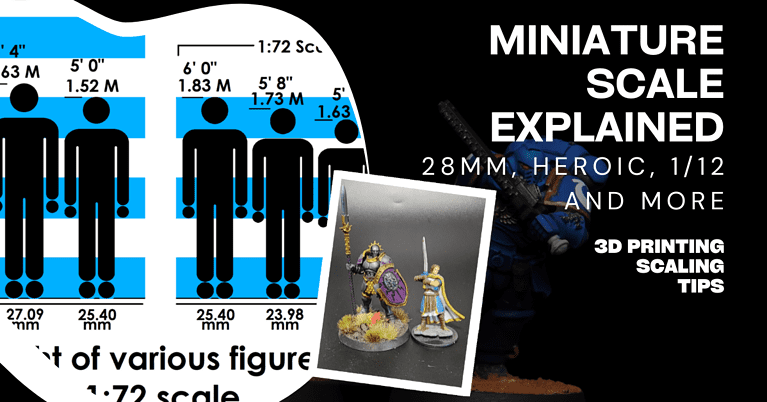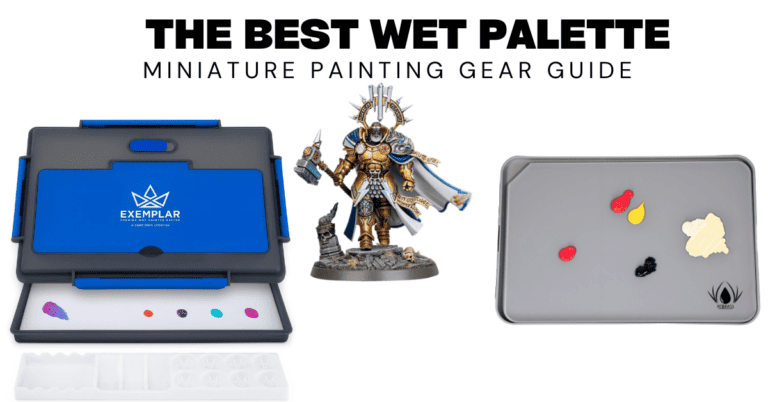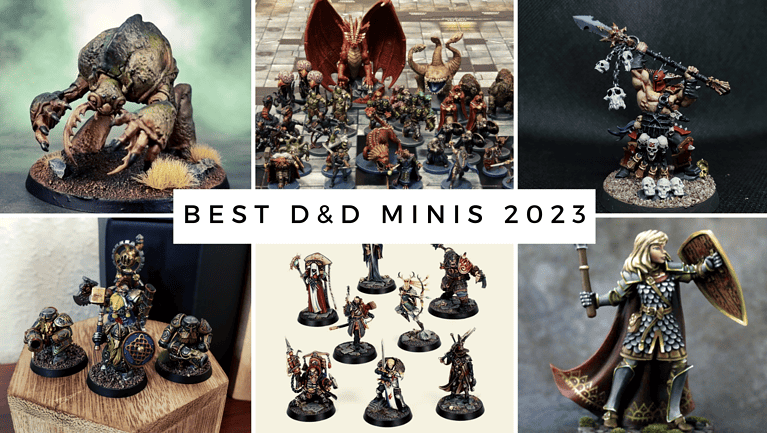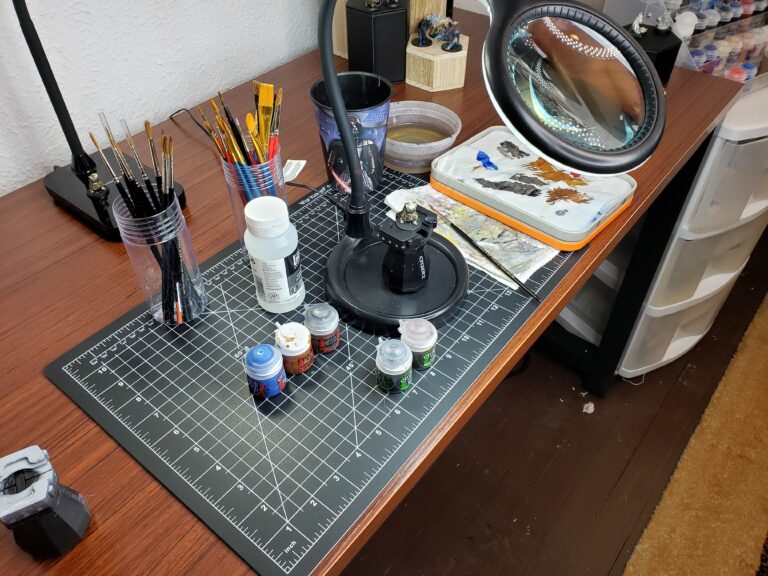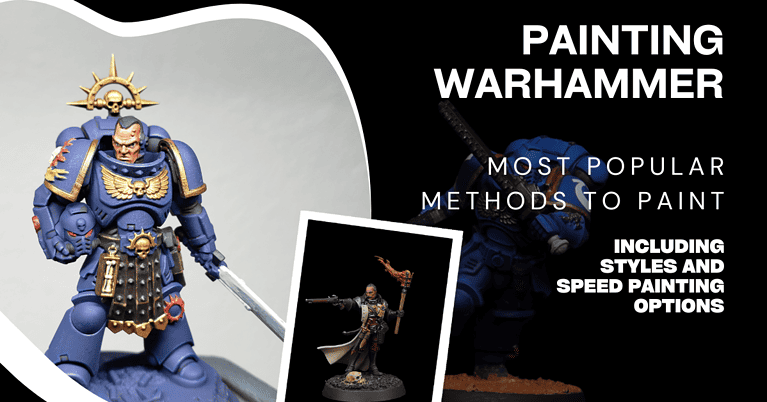What Is Tabletop Wargaming in 2023: Explained (Best in Miniature Wargaming)
Miniature and Tabletop Wargaming in 2023: Summary
What is the Tabletop Wargaming hobby?
What is Tabletop Wargaming? Tabletop wargaming is a strategy game played on a flat surface, where participants can use miniature figures or tokens, or imagination, terrain pieces, and specific rulesets to simulate battles and conflicts. These games can encompass historical, fantasy, or sci-fi settings, requiring players to employ tactics and strategy to achieve objectives and defeat their opponents.
What is Miniature Wargaming?
What is Miniature Wargaming? Miniature wargaming is a form of tabletop strategy game where players use miniature figures, terrain, and rulesets to simulate battles, ranging from historical conflicts to fantasy skirmishes. The game combines tactical thinking, detailed miniatures, and often intricate landscapes to create immersive scenarios and challenges for participants.
What is the difference between Miniature and Tabletop Wargaming?
- Miniature Wargaming specifically refers to wargaming that uses miniature figures and terrain to represent combatants, landscapes, buildings, and other features. The emphasis is on the physical representation and often includes detailed modeling and painting.
- Tabletop Wargaming is a broader term that encompasses any wargame played on a table or flat surface, including those that use miniatures. It can also include games that use counters, chits, or other markers instead of three-dimensional miniatures.
So, while all miniature wargames are tabletop wargames, not all tabletop wargames necessarily use miniatures. However, in casual conversation, the terms are often used interchangeably.
Popular Miniature Games Examples:
Sci Fi Miniature Wargames
Warhammer 40k: This is the biggest miniature game of them all. Games Workshop developed 40k back in the 1980’s and it’s since grown to a huge following. 40k is a grimdark sci-fi universe. It allows players to build, assemble and paint extremely high quality and detailed miniatures to represent the armies on the tabletop.
There are volumes of lore, tons of miniatures and terrain, video games, expansions, and a huge community. There are even plans for a Warhammer live action TV show on Amazon starring Henry Cavil.
40k Space Marine miniatures are by far my most painted models. The two Warhammer 40k Ultramarines on the homepage are mine, and here is a shot of just a small part of one of my Imperial Fist armies:
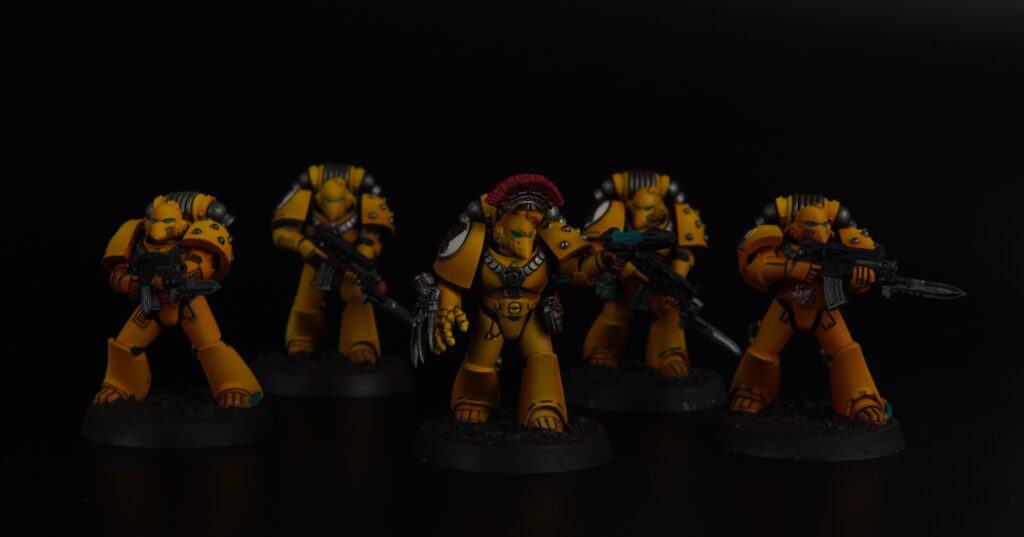
Star Wars Legion: This is one of the bigger Star Wars miniature games, developed by Fantasy Flight Games. Fantasy Flight Games has moved their Star Wars miniatures over to Atomic Mass Games as of November 2020. Atomic Mass now does all the popular Star Wars miniatures. Shatterpoint, Legion, X-Wing and Armada. (Not to mention Marvel Crisis Protocol).
These are also very high quality miniatures. The detail is fantastic and they offer a wide range of characters and vehicles.

Fantasy Miniature Wargames
Age of Sigmar: This is another Games Workshop property, and another of my personal favorites. Think of it as more of the D&D fantasy setting for Warhammer. Games Workshop replaced Warhammer Fantasy Battles with Warhammer: Age of Sigmar in 2015. It caused quite a bit of concern for Fantasy players.
I love Sigmar personally, and I’ve painted up a Stormcast Army, part of which you can see here:
(Stormcast Army Image)
Another important thing to note is that Games Workshop has announced plans for the Old World which is a throwback to the Warhammer Fantasy series. It will feature the Tomb Kings, Bretonians and more.
Paladin of Bretonnia and Tomb King from the Old World
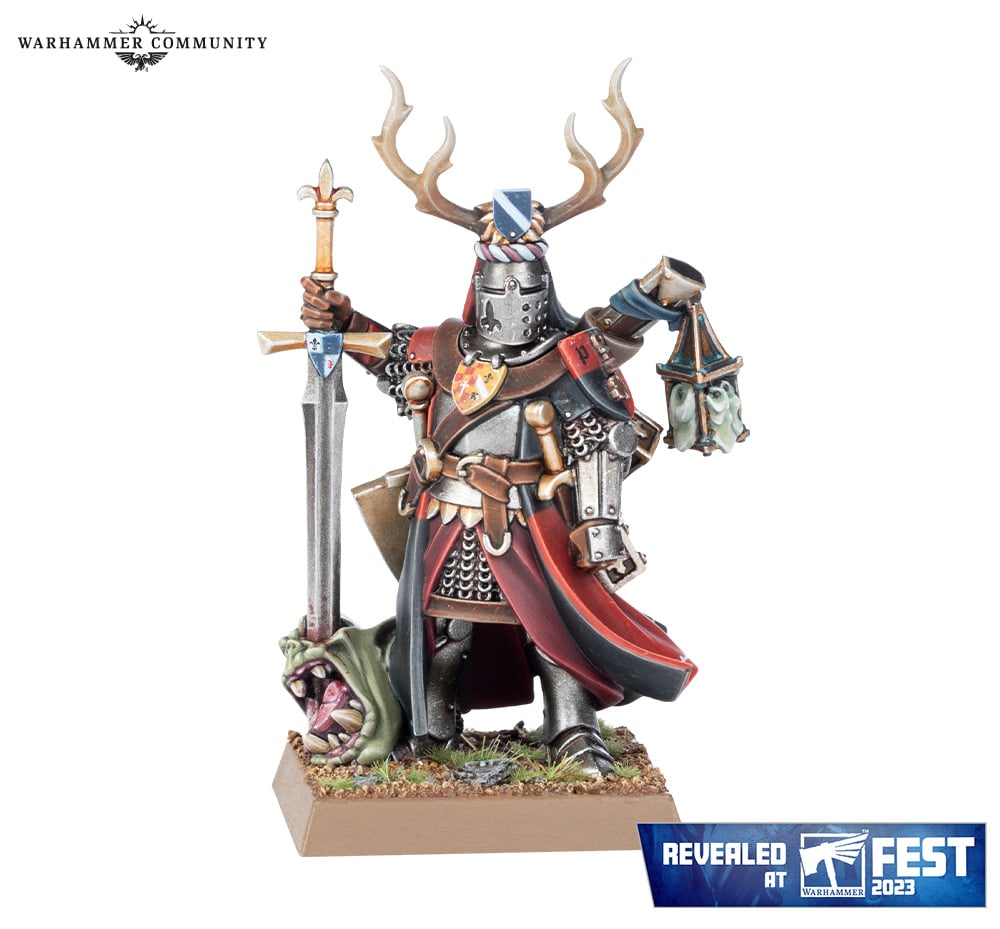
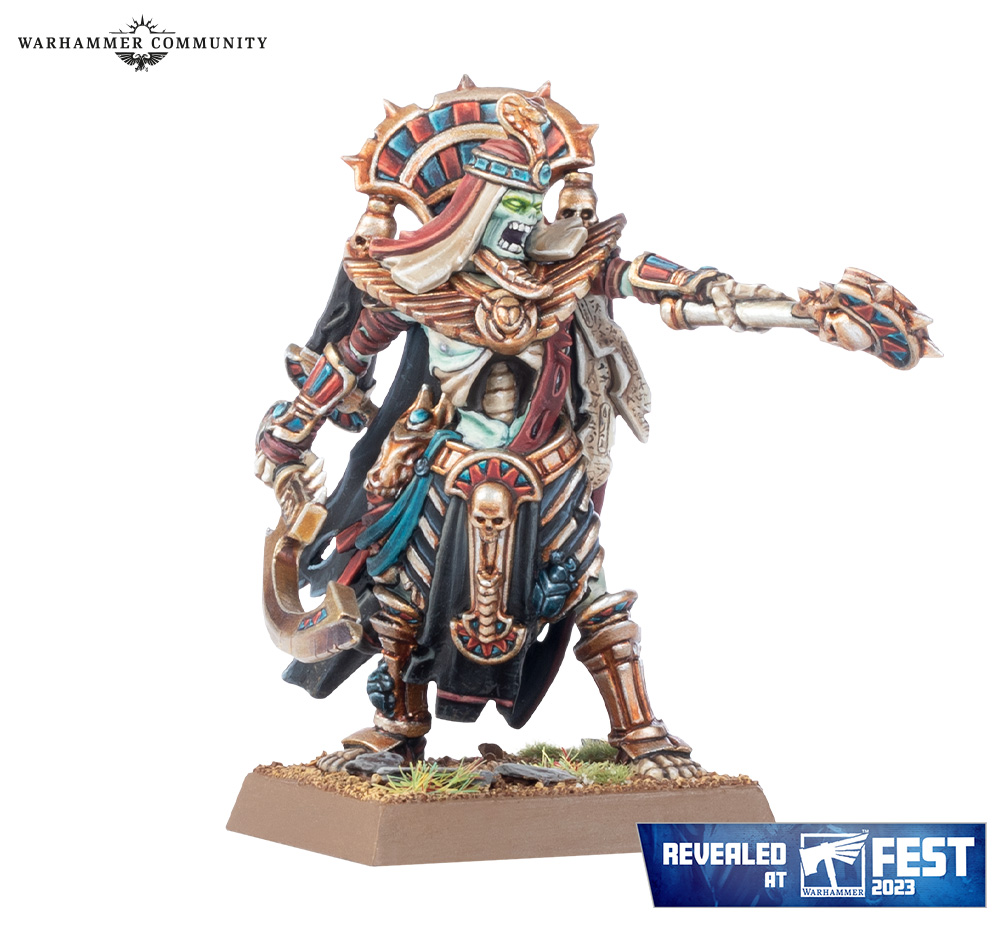
Dungeons and Dragons: No credible discussion of Tabletop Roleplaying Games is complete without mentioning D&D. You can play with pen, paper and a rulebook, or add miniatures to the game. I’ve written a lot about DnD 5e on my other sites. Right now I’m playing Baldur’s Gate 3, which is a D&D based video game and HIGHLY recommended.
D&D is played on tabletop and can be with or without miniatures. You can also play it online in what’s known as a virtual tabletop, or VTT.
WWI & II and other Historical Miniature Wargames
Bolt Action: this is a WWII 28mm tabletop miniature wargame by Warlord Games. They focus on tactical battles and have a wide range of terrain, units, artillery, vehicles and more.
Flames of War: A 15mm (so very small!) miniature wargame also based on WWII.
Wings of Glory: A WWI aerial dogfight game made by Ares games.
Other Popular Miniature Wargames
Marvel Crisis Protocol: From the same crew that makes the Star Wars miniatures, Atomic Mass Games does Marvel Crisis. You can find all the Marvel miniatures of your favorite heroes and villains. Captain America, Spiderman, Ghost Rider, Dr Octopus, Groot, Dormamu… just tons of options. Worth looking into if you love Marvel.
Zombicide 2nd Edition: Who doesn’t love a good zombie game? This is co-op so it’s a ton of fun with friends or family. 6 Hero minis and a bunch of zombies. Fast paced, easy to pick up and well made. CMON is a veteran of miniature gaming and very well known in the miniature wargaming community.
A Song of Fire and Ice: For any Game of Thrones fans out there, this one is for you. It’s another CMON product and another great source of plastic miniatures to go with a fun game experience. You’ve got the classic Stark v Lannister set and some expansions to pick from.
Examples of Tabletop Wargames without Miniatures:
Flying Colors: The Age of Sail: Great naval combat game that’s easy to learn and play. No miniatures here, you’ll use tokens to represent your fleet. It’s dice based and the rules are straightforward for movement, range, boarding actions and firepower. I found a great explainer video here:
Panzer: Another Dice, Map and Token game by GMT, this time with Tanks instead of Ships. Everything you need is included.
Salerno ’43: Finally, here is the Allied invasion of Italy as represented by GMT. I wouldn’t recommend for beginners unless this specific campaign is drawing you in. It’s a good game with similar rulesets but it’s a bit hard to pick up for a complete beginner.
Models and Tabletop Miniatures: Uses in Tabletop Gaming
Tabletop miniatures have been around for a long time. H.G. Wells publishing his book “Little Wars” back in 1913, but the hobby has roots back even further . But what do these miniatures actually do, and how do different aspects, like size and terrain, factor into the gaming experience?
What Do Miniatures Do in Tabletop Gaming
Miniatures are a physical representation of units, characters, and creatures within a game. Miniature models in war games have a lot of uses:
- Tactical Immersion: Miniatures provide players with a tangible, three-dimensional representation of the game’s inhabitants. It’s much easier to picture the environment surrounding them. How near or far other units are for example. Lines of sight. Flanking opportunities. This makes strategic decisions and tactical maneuvers more intuitive and visually clear.
- Personalization: For many gamers, including me, assembling and painting miniatures is as enjoyable as the game itself. Painting your own character in a D&D campaign for example. Or a realistic uniform on an American civil war model. Having done it yourself makes the attachment more significant.
- Rules & Mechanics: In many games, the positioning, facing, and distance between miniatures can affect gameplay due to line of sight, attack ranges, and other mechanics. For example, Games Workshop’s games have very specific movement phases that require dice rolls and measuring how far the units can go. Not to mention terrain effecting line of sight. This requires players to consider the physical layout of the board, adding a layer of strategic depth.
Miniature Sizes
Miniature sizes can vary widely depending on the game, genre, and manufacturer. The scale of a miniature often determines the level of detail, the scope of the battles, and the overall feel of the game. Common scales include:
- 6mm (1:285 scale): Typically used for grand battles with large armies.
- 15mm: Popular for historical wargaming, allowing for a balance of detail and scope.
- 28mm (often 1:56 scale): One of the most common sizes, particularly in fantasy and skirmish games. They provide a good level of detail and are often used in games where individual character actions are important.
- 54mm: Larger figures often used for dioramas or display but occasionally seen in gaming.
Different scales can drastically affect gameplay. For example, a 6mm game might simulate an entire World War II battle, while a 28mm game might focus on a skirmish between individual squads.
In wargaming conventions a lot of people will have entire armies with massive amounts of 28mm or bigger scale units.
What is the Function of Terrain on a Tabletop Battlefield
Terrain plays a pivotal role in tabletop wargaming, adding depth and complexity to the strategic landscape. Here’s how:
- Tactical Implications: Terrain can provide cover, obstruct movement, or offer vantage points. Forests might block line of sight, while hills could give ranged units an advantage. Understanding and leveraging terrain is often key to victory.
- Thematic Immersion: A well-crafted terrain enhances the game’s atmosphere. A fantasy battle feels more authentic when fought in a dense forest or atop a dragon-bone littered wasteland.
- Rules and Boundaries: Many games have specific rules regarding terrain. Marshlands might slow movement, rivers could be impassable without bridges, and urban areas might offer protection against certain types of attacks.
- Player Creativity: Just as with miniatures, creating and customizing terrain is a hobby in its own right. Crafting realistic or fantasy landscapes can be a deeply rewarding process, enhancing the overall gaming experience.
Many companies sell plastic terrain that you assemble and paint, or fully ready to go options. Companies like Dwarven Forge for example has a lot of D&D fantasy themed terrain. I personally love Battlefield in a Box by Gale Force Nine. They are inexpensive, very cool and fully ready to go. You can find anything from Dragon graveyards, to Egyptian themed Sphinxes, to Sci-Fi space bunkers.
Overview of the Rules and Gameplay in a Tabletop Wargame
Tabletop wargaming rules vary, but many games share common mechanics and concepts.
Units: Units typically represent individuals, groups of soldiers, heroes, vehicles, monsters, or things like animals. Each unit usually has its own set of stats, They let you know how fast it moves, how tough it is, hit points, its combat strength, and any special abilities or rules it might have.
Points: In many wargames, players assemble their armies based on a points system. Each unit or model has a points value based on stats and abilities, or impact on the game. By limiting the number of points each player can spend, the game ensures both sides have roughly equal chances of winning, which encourages strategic army-building.
Points are a common way of trying to find game balance. You find the points either online or in rulebooks. Warhammer 40k for example will periodically rebalance their game and alter point values.
Movement: How quickly you can get across the battlefield or relocate your position.
- Measurement: Typically, players use rulers or measuring tapes to move units the exact distances allowed by their statistics.
- Terrain & Obstructions: These can impact movement. Woods might slow infantry, while steep hills could be impassable to vehicles.
- Engagement: Some games restrict movement if a unit is in close proximity to enemy units, representing the chaos of close combat.
Combat: Wargames mean combat, which can be ranged attacks with archery or firearms to close combat with swords or claws.
- Rolling Dice: Most wargames use dice to introduce an element of chance to combat. The number of dice rolled, the required result, and any modifiers are usually determined by the units’ statistics and the situation on the battlefield.
- Resolving Hits: After determining hits, additional rolls or calculations might determine wounds or damage. Units might have armor values or save mechanisms to resist damage.
- Special Abilities & Weapons: Unique weapons or abilities can introduce additional rules or effects, such as area damage, poison, or morale penalties. The player (you) typically can choose if and when you use these. Sometimes you’ll save them and other times use them often.
Win Conditions: While the basic goal might be to defeat the enemy army, many games introduce specific objectives or scenarios.
- Objective Control: Some games focus on capturing and holding certain points on the map.
- Scenario Play: Players might reenact a historic battle, complete with its unique victory conditions, or follow a narrative scenario with its own goals and rules.
- Elimination: In simpler games, the aim may just be to eliminate all of the opposing forces.
Other Mechanics: There are sometimes mechanics to add special flavor to the game you’re playing.
- Morale: Represents the fighting spirit of units. Units suffering heavy losses, facing terrifying enemies, or trapped in unfavorable situations might break and run from the battle or suffer attack penalties.
- Magic & Special Abilities: In fantasy wargames, spellcasting or abilities can play a significant role, with their own set of rules and effects.
- Turn Sequence: Games usually follow a structured sequence of play, such as a movement phase, a shooting phase, and a combat phase.
Tabletop Wargames: Getting Started with the Miniature Wargaming Hobby
Choosing your First Miniature Wargame
My honest advice here is to look around and follow the “rule of cool”. Which is simply, what looks cool? What looks fun? What looks interesting?
If you see a board game with toy soldiers on it and that looks interesting, look into it.
If you like history, specifically world wars or empires, check out the wide range of historical wargames out there. Anything from the Roman Empire to World War II is represented. Military wargames are
I tend to lean towards Fantasy games like D&D or Pathfinder. I’m also really drawn in by Sci Fi. My favorite thing about the hobby is the miniatures, so I find myself looking at Games Workshop warhammer games 90% of the time. They have fantasy and sci fi, and the best quality miniatures around.
Not to mention a huge community, great box art to follow, and support. I know I sound like I’m promoting them somehow but I promise it’s just because I enjoy the hobby so much.
Choosing a Set of Miniatures
Once you have a system they will typically come with sets of miniatures. Warhammer has starter sets. A Song of Fire and Ice have base sets and expansions. Games like Zombicide don’t have many choices to make, it’s all in one box.
For Warhammer and similar games though, you need to pick an army. Here again I recommend looking over options and see what you are drawn to. I love Space Marines, you might love Necrons or Death Guard. I am drawn to Stormcast Eternals, you might like Eldar.
Find a faction like like the aesthetic of and pick either a single unit or small set to start with. Assemble and paint, then build your army from there.
Small skirmish games like Kill Team are great for this as they don’t require many models. Popular Skirmish games include:
- Necromunda
- Warcry
- Warhammer Underworlds
- Frostgrave
- Infinity
- Star Wars: Legion
- Malifaux
- Gaslands
Joining a Tabletop Games Community
If you’re into D&D check out your local gaming shop or comic store. Many of them run D&D or similar games.
If you are interested in Warhammer 40k or Age of Sigmar see if there is a Warhammer store nearby. They hold tournaments and give free workshops on painting all the time.
There are many miniature wargaming communities locally and online.
Online Tabletop Game Communities you can try:
Meetup: Tabletop-Games
Facebook: Facebook Tabletop Gaming
Reddit: Warhammer40k or Wargaming
History of Miniature Wargames and Wargamers
The first widely recognized miniature wargame was Little Wars by H. G. Wells, published in 1913. Wells took inspiration from the tin soldiers used by children to recreate battles and developed a set of rules providing a more strategic and mature gameplay experience. Little Wars was the first wargaming model that incorporated the use of miniatures, terrain, and range finders to simulate realistic battles.
In the 1950s, a shift in miniature wargaming was spurred by the efforts of Jack Scruby, a pioneer in the creation and casting of detailed metal miniatures. Scruby produced affordable figures in various historical periods, which led to the growth of wargaming clubs and conventions in the United States. He also founded a company, known as Tabletop Games, supplying enthusiasts with his wargame miniatures.
Jack Scruby was passionate about historical accuracy, contributing to the development of game rules that reflected authentic battlefield tactics and techniques. His games tried to recreate historical battles in historical settings.
The popularity of miniature wargaming grew and diversified in the 1970s, thanks in part to Gary Gygax. Gygax, along with Dave Arneson, created the iconic Dungeons & Dragons (D&D) role-playing game. D&D fused elements of historical wargaming with high fantasy, allowing players to assume the roles of characters and create their own adventures. Many D&D players incorporated miniature figures into their games, boosting the popularity of the hobby.
Games Workshop, a British company founded in 1975, further revolutionized the miniature wargaming landscape. Originally a distributor of American role-playing games, Games Workshop developed their own wargaming system called Warhammer. Warhammer became a tremendous success, leading to spin-off games such as Warhammer 40,000, Age of Sigmar, Warhammer Fantasy Battles, and more.
Today, miniature wargaming continues to evolve and adapt, with many different historical, sci fi, horror and fantasy themes being translated into game systems. The hobby has also embraced new technologies, such as 3D printing, and crowdfunding like Kickstarter.
3D printers allow players to simply download and print individual models they need. Kickstarter eliminates a lot of the upfront costs of developing a wargame set or board game.
There are also “miniature agnostic” games out there like Reign in Hell. These games allow you to use any miniature you want to represent their factions. Developers make the game rules, and you provide whatever miniature figurines you have available.
I hope this has helped you understand more about tabletop wargaming. Being with friends and family around a table rather than online makes a game fun. That is the heart of tabletop gaming.

